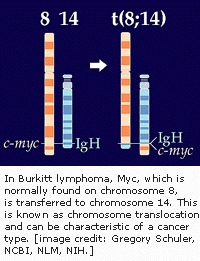NCBI Bookshelf. A service of the National Library of Medicine, National Institutes of Health.
National Center for Biotechnology Information (US). Genes and Disease [Internet]. Bethesda (MD): National Center for Biotechnology Information (US); 1998-.

Burkitt lymphoma results from chromosome translocations that involve the Myc gene. A chromosome translocation means that a chromosome is broken, which allows it to associate with parts of other chromosomes. The classic chromosome translocation in Burkitt lymophoma involves chromosome 8, the site of the Myc gene. This changes the pattern of Myc's expression, thereby disrupting its usual function in controlling cell growth and proliferation.
We are still not sure what causes chromosome translocation. However, research in model organisms such as mice is leading us toward a better understanding of how translocations occur and, hopefully, how this process contributes to Burkitt lymphoma and other cancers such as leukemia.
- Genome view see gene locations
- Entrez Gene collection of gene-related information
- BLink related sequences in different organisms
- Research articles online full text
- Books online books section
- OMIM catalog of human genes and disorders
- CancerNet from the National Cancer Institute, NIH
- American Cancer Society research and patient support
- Oncolink comprehensive cancer information from the University of Pennsylvania
- Burkitt lymphoma - Genes and DiseaseBurkitt lymphoma - Genes and Disease
Your browsing activity is empty.
Activity recording is turned off.
See more...
